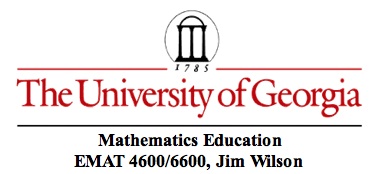
PROBLEM SOLVING WITH HERON'S FORMULA

Introduction
Heron's formula for the area of a triangle with sides of length a, b, c is
where
It is unfortunate that this topic has essentially disappeared from school curriculum today. Calculation, given available calculations and computers, can no longer be a reason for avoiding the formula. In what follows, I hope to show some interesting and challenging problems using Heron's formula.
Whether or not one would pose the demonstration or proof of Heron's formula for a particular class would depend on the class. Initially, exploration with Heron's formula could involve computing areas using the formula and making comparison's of the results -- much as we pose analogous exercises in a meaningful way with the Pythagorean theorem long before a proof or demonstration is fully understood.
For instance, one exercise could be to have students measure the sides and an altitude on several triangles and, with calculator, compute the areas with both formulas
Comparison of the results could well lead to intuitions about the areas of triangles and understanding of when one formula would be more applicable than the other.
Heron's Formula
The demonstration and proof of Heron's formula can be done from elementary consideration of geometry and algebra. I will present an algebraic proof here. Alternative proofs and derivations are suggested on the Jwilson web site, Heron's Formula and a particularly concise geometric proof is given at Heron's Formula, Geometric Proof.
I will assume the Pythagorean theorem and the area formula for a triangle
where b is the length of a base and h is the height to that base.
We have
so, for future reference,
2s = a + b + c
2(s - a) = - a + b + c
2(s - b) = a - b + c
2(s - c) = a + b - cThere is at least one side of our triangle for which the altitude lies "inside" the triangle. For convenience make that the side of length c. It will not make any difference, just simpler.
Let p + q = c as indicated. Then

This demonstration of Heron's formula is straightforward and elementary. Working through it with students can provide fruitful ideas of strategy, symmetry, planning, and observation. We now switch to consider some problems and investigations for which Heron's formula is useful.
Problem:
Show that the maximum area of a triangular region with a fixed perimeter occurs for an equilateral triangle.
Comment. I would adapt the statement and context of this problem depending on the background of the students. Above, I mentioned an exploratory investigation where students looked at different triangular regions that could be formed with a perimeter of 100 feet. Now extend this. Have students organize a table where the lengths of the sides are varied systematically .
In order to vary something "systematically" one needs to identify a variable that can be ordered in the table. For example, investigate the more manageable problem of isosceles triangles. Let the side of length a be the base to vary from 2 to 48 in steps of 2, as followsThis table can be generated with a calculator in only a few minutes and the data open up lots of opportunity for discussion, plausible reasoning, and problem posing.
- For example, four of the lines in the table will show triangles with integer areas. Are there other triangles (non-isosceles) with perimeter of 100 having integer sides and integer area?
- Incidentally, in looking at this table and interpreting it, students might be led to realize that for any selected length for a base, the isosceles triangle would have the most area for all triangles with perimeter of 100 units that could be constructed on that base.
Once the table is complete, consider having the students plot a graph with the length of a on the x-axis and the area on the y-axis. The resulting curve provides more opportunities for plausible reasoning.
Let us return now to showing that the equilateral triangle has the most area for any fixed perimeter.
and equality occurs when s - a = s - b = s - c, that is, a = b = c. Since the product is always less than this constant, this constant is the maximum for the product and the maximum area of a triangle with a fixed perimeter 2s is
The equilateral triangle has that maximum area. For instance, the maximum area for all triangles having a perimeter of 100 is
Problem:
Interpret the condition
s(s - c) = (s - a)(s - b)
What can be concluded for any triang
le for which the condition holds?
Investigations:
- Find triangles having integer area and integer sides.
- Find a triangle with perimeter 12 having integer area and integer sides.
- Find a triangle having integer sides and integer area that is not a right triangle. Can you find others? Generalize.
- Find the smallest perimeter for which there are two different triangles with integer sides and integer area.
- Find 5 triangles with perimeter of 100 units having integer area and integer sides.
- Find all the triangles with perimeter of 84 having integer sides and integer area.